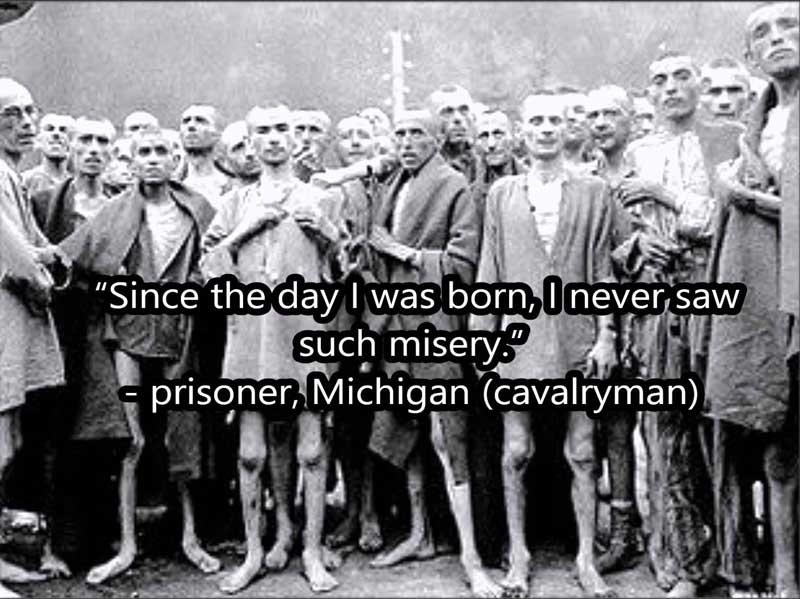A Humanitarian Crisis Made in Washington

The truth about the tragedy of Andersonville is much different from the propaganda version that prevailed after the Civil War and still flourishes in politically correct media.
Near the tiny village of Andersonville, Georgia, are 13,714 graves, a testament to one of the greatest tragedies of the Civil War and of American history. In fourteen months of 1864 and 1865, nearly 13,000 Union prisoners of war died there of malnutrition, disease, and despair. Union propagandists then and still today have branded it an atrocity. But what is the truth?
Late in the war, the Confederate government decided it needed to move its Union POWs to locations far removed from the most active areas of combat and vulnerability to attack. New locations also needed to be near railroad transportation and plentiful agricultural supplies to feed the prisoners and Confederate infantry units assigned to guard them. They found what they thought was an excellent location in southwest Georgia at Station Number 8 on the Georgia Southwestern Railroad line. A small community of six buildings, called Andersonville, had grown up around that station.
The Confederates had planned to build a full scale prison with barracks and other facilities there, but by early 1864 the South was being strangled by the Union Navy blockade and Union Army advances that crippled railroad and other transportation. The area was heavily wooded, but due the general lack of manpower and other building materials, it became impossible to build barracks. The Confederate government was forced to the cheapest and most expedient alternative, a stockade, a mere coral, initially encompassing just over 16 acres in which to confine prisoners. The facility was meant to hold no more than 10,000 prisoners.
The first Union POWs were transferred from the upper South in late February 1864. Many of these prisoners were already in poor health. Colonel Alexander Persons of the 55th Georgia Infantry was placed in charge. Captain Henry Wirz, who was made responsible for the prisoners, and who later became the scapegoat for the Andersonville tragedy, did not arrive there until March 25 and was never in overall command.
By June, when General John Winder was placed in overall charge and expanded the compound to 27 acres, there were already over 22,000 prisoners there, and more than 2,600 had died. By August, 34,000 prisoners were crowded into the compound. This crowding caused many sanitation problems. Newly arriving prisoners often vomited from the smells. In addition, because of Union advances using the total-war tactics of burning crops and barns and either confiscating or killing domestic animals, food supplies were scarce everywhere in the South.
The first POW arrivals built huts with left over lumber, and subsequent arrivals put up tents within the compound. Food rations soon had to be reduced because of growing shortages. Union prisoners there, however, received the same rations as their Confederate guards throughout the war. U.S. War Department policy, moreover, prevented medical supplies from reaching the South, severely handicapping treatment of sick and wounded prisoners.
The tragic situation at Andersonville could have been much relieved if prisoner exchanges had been allowed to continue. But Lincoln and Secretary of War Edmund Stanton decided that prisoner exchanges favored the Confederates too much, desperate as they were for manpower replacements against the increasing numerical superiority of Union forces.
James Madison Page of the 6th Michigan Cavalry, who was interned at Andersonville from its beginning until transferred in mid September to Millen, Georgia, published his memoirs on Andersonville in 1908, entitled, The True Story of Andersonville Prison. He quotes an August 1, 1864 statement by Secretary of War Stanton that flattened the morale of Union POWs.
“We will not exchange able-bodied men for skeletons…We do not propose to reinforce the rebel army by exchanging prisoners.”
Later the Confederates offered to give up their Andersonville prisoners without exchange, if only Union ships would pick them up. But despite their suffering, Stanton decided to leave them as a burden to Confederate forces.
The principal causes of death at Andersonville were dysentery, diarrhea, scurvy, typhoid, small pox, and hospital gangrene. Of course, malnutrition greatly increased vulnerability to these diseases. Many of the men were very emaciated, and photos of them later enraged the Northern public. According to Page, about one half the prisoners suffered from scurvy. Page stated that:
“As bad as was the physical condition of the prisoners, their mental depression was worse and more fatal.”
“Captain Wirz, on the advice of medical officers, put in operation the brewing of “corn beer.” This was very effective in reducing scurvy in the camp and improved morale.
Nearly 45,000 Union prisoners spent time at Andersonville. Of these, 12, 912, or about 29 percent, died. The Confederate guards, however, subject to the same diet and diseases, died at the same rate. Approximately 270,000 Union soldiers were held prisoner during the war, and 22,576, or just over 8 percent, died. More than half of the total Union POW deaths were at Andersonville. Of the 220,000 Confederates held prisoner during the war, in excess of 26,000 or nearly 12 percent died.
It should be noted that despite the tragedy at Andersonville, Southern POWs died at a rate at least 41 percent higher than Union POWs. At least 23 percent of Confederate prisoners interned at Camp Douglas in Illinois and approximately 25 percent of those held prisoner at Elmira, New York, died. George R. Farr, Historian for the Town of Elmira, clearly states the reason for the higher Confederate death rate.
“The prison records (at Elmira) show that prisoners typically died from Typhoid Fever, Chronic Diarrhea, and Pneumonia. What the records do not show is that the cause of death was often partly due to malnutrition. It is evident that military officials, many with a strong hatred for the South, from Secretary Stanton on down had some part in preventing adequate supplies of food being furnished to the prisoners. There can be no other explanation because this prison (Elmira) was located in a fertile, rich, agricultural part of New York State where food shortages just did not exist.”
Especially during the last part of the war, the Confederate armies were starving, while the Union armies were well fed and equipped to the last tent peg. Under the direction of Secretary of War Edwin Stanton, and with the complicit agreement of Abraham Lincoln and his highest ranking generals, the North pursued a policy of deliberate maltreatment of Southern prisoners, principally by lowering their food rations. At the same time, the Southern policy was to give the same rations to Union POWs as their own soldiers. Toward the end of the war, the entire corn reserve of the Army of Northern Virginia was transferred to Confederate prison camps.
There was little physical abuse of prisoners at Andersonville. After the first of 329 escapes at Andersonville, a “deadline” was marked 20 feet from the stockade walls. A few prisoners were shot crossing that line. This information was used to “wave the bloody shirt” in the Northern press, stirring up hatred for the South. What the War Department and Northern press did not reveal is that “deadlines” were common to all Northern and Southern POW camps.
Most of the few violent deaths of prisoners at Andersonville were the result of an internal struggle between an organized criminal band within the compound, responsible for robbing and murdering vulnerable prisoners, and a group of elected “regulators” that brought them to justice with the approval of Confederate authorities. The Union robbers were arrested and tried by the Union regulators. After trials, the Union regulators hanged six of the criminals. Another three were beaten to death in resisting arrest.
At the end of the war, Secretary of War Stanton was anxious to put the blame for Andersonville somewhere other than the War Department. He would have preferred to pin the responsibility on Confederate President Jefferson Davis, but that failed. Major Wirz was demonized by perjured testimony and made the scapegoat. Wirz, his lawyer, and his priest were told by representatives of “a High Cabinet Official” that he would be pardoned, if he would implicate Jefferson Davis. He did not and was hanged. In a shameful distortion of justice, the trial by Military Commission used perjury, bribery, and intimidation to force a predetermined guilty verdict. All charges of murder and other serious crimes brought against Wirz during the War Department trial have since been decisively refuted.
In a letter to Jefferson Davis in 1880, Father F. E. Boyle gave this testimony of Wirz:
“I attended the Major to the scaffold, and he died in the peace of God and praying for his enemies. I know that he was indeed innocent of all the cruel charges on which his life was sworn away, and I was edified by the Christian spirit in which he submitted to his persecutors.”
Many people in the North were outraged by Wirz’s shameless trial and execution. In December 1865, the New York News published a letter from Macon, Georgia, ending in these words:
“The radical conspirators against history may have the ear of the world just now, but sooner or later the truth will come out. ‘The eternal years of God are hers.”
‘I have seen the wicked in great power, and spreading himself like a green bay tree; yet he passed away, and lo! He is not.” (Psalm 37: 35-36a)









 Mike Scruggs is the author of two books: The Un-Civil War: Shattering the Historical Myths; and Lessons from the Vietnam War: Truths the Media Never Told You, and over 600 articles on military history, national security, intelligent design, genealogical genetics, immigration, current political affairs, Islam, and the Middle East.
Mike Scruggs is the author of two books: The Un-Civil War: Shattering the Historical Myths; and Lessons from the Vietnam War: Truths the Media Never Told You, and over 600 articles on military history, national security, intelligent design, genealogical genetics, immigration, current political affairs, Islam, and the Middle East. 


